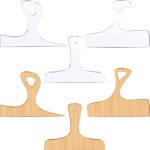Master The Art Of Woodworking Projects Using Hand Tools: Unlock Your Creativity And Start Crafting Today!
Woodworking Projects Using Hand Tools: A Journey of Creativity and Skill
Woodworking has always been a craft that combines creativity, skill, and an appreciation for the beauty of natural materials. While power tools have made their mark in the industry, there is something uniquely satisfying about working on woodworking projects using hand tools. The process of shaping, carving, and assembling wood with your own two hands allows for a deeper connection with the material and a greater sense of accomplishment. In this article, I will share my experience and insights on woodworking projects using hand tools, exploring the what, who, when, where, why, and how of this fascinating craft.
What are Woodworking Projects Using Hand Tools?
Woodworking projects using hand tools refer to the art of creating functional or decorative items using manual tools such as saws, chisels, planes, and hammers. These projects often involve traditional joinery techniques, where pieces of wood are carefully fitted together without the aid of screws or nails. From crafting intricate wooden boxes to building elegant furniture, the possibilities are endless when it comes to woodworking projects using hand tools.
2 Picture Gallery: Master The Art Of Woodworking Projects Using Hand Tools: Unlock Your Creativity And Start Crafting Today!


Who Can Engage in Woodworking Projects Using Hand Tools?
Woodworking projects using hand tools are suitable for individuals of all ages and skill levels. Whether you are a seasoned woodworker or a beginner looking to explore a new hobby, working with hand tools offers a fulfilling and enriching experience. It allows you to develop a deep understanding of the woodworking process and hone your craftsmanship skills.
When and Where Can Woodworking Projects Using Hand Tools Be Done?

Image Source: i0.wp.com
Woodworking projects using hand tools can be done at any time and in any suitable location. Unlike power tools, hand tools do not require access to electricity or a dedicated workshop. You can work on your projects in your backyard, on your balcony, or even in a small corner of your living room. The versatility of hand tools makes woodworking accessible to anyone, regardless of their living arrangements or constraints.
Why Choose Woodworking Projects Using Hand Tools?
Choosing woodworking projects using hand tools offers a range of benefits. Firstly, it allows for a slower and more mindful approach to woodworking. Since hand tools require manual effort, each cut and each stroke becomes a deliberate action, fostering a sense of mindfulness and focus. Additionally, working with hand tools is quieter and less disruptive, making it more suitable for those who live in shared spaces or prefer a calmer working environment.
Secondly, woodworking projects using hand tools offer a greater connection to the material. As you shape and carve the wood with your hands, you can truly appreciate its unique grain patterns, textures, and colors. This hands-on approach allows for a deeper understanding and appreciation of the natural material, resulting in a stronger bond between the craftsman and their creation.

Image Source: renaissancewoodworker.com
Lastly, hand tool woodworking projects offer a sense of achievement and personal satisfaction. The process of transforming a rough piece of wood into a finely crafted item solely through your own effort is incredibly rewarding. Each completed project becomes a testament to your skills, creativity, and perseverance.
How to Get Started with Woodworking Projects Using Hand Tools?
Getting started with woodworking projects using hand tools is easier than you might think. Here are a few steps to guide you on your journey:
1. Familiarize Yourself with Hand Tools:
Begin by familiarizing yourself with the different types of hand tools used in woodworking. Learn about their functions, how to use them safely, and how to maintain them properly.
2. Start with Simple Projects:
Choose simple projects to begin with, such as a wooden spoon or a small jewelry box. This will allow you to practice basic woodworking techniques and gain confidence in working with hand tools.
3. Learn Joinery Techniques:
Master traditional joinery techniques, such as dovetail joints or mortise and tenon joints. These techniques are the foundation of hand tool woodworking and will enable you to create strong and durable connections between wood pieces.
4. Expand Your Skills:
As you gain experience, gradually expand your skills and tackle more complex projects. Experiment with different wood species, explore new joinery techniques, and challenge yourself to create unique and intricate designs.
5. Join a Woodworking Community:
Joining a woodworking community, whether online or in-person, can provide a wealth of knowledge and support. Interacting with fellow woodworkers can inspire you, offer valuable advice, and provide opportunities for collaboration.
Frequently Asked Questions about Woodworking Projects Using Hand Tools
Q: Do I need expensive tools to start woodworking projects using hand tools?
A: While high-quality hand tools can enhance your woodworking experience, they are not necessary to get started. Begin with a few essential tools and gradually expand your collection as you progress.
Q: What type of wood is best for woodworking projects using hand tools?
A: The type of wood you choose depends on your project and personal preferences. Hardwoods such as oak, maple, and walnut are popular choices due to their durability and beautiful grain patterns.
Q: Can I achieve the same level of precision with hand tools as I can with power tools?
A: Yes, with practice and fine-tuning your skills, you can achieve remarkable precision using hand tools. The slower pace allows for greater control and attention to detail.
Q: Are there any disadvantages to woodworking projects using hand tools?
A: Working with hand tools requires physical effort and can be time-consuming compared to power tools. Additionally, certain tasks such as milling large pieces of wood may be more challenging with hand tools.
Conclusion
Woodworking projects using hand tools offer a unique and rewarding experience for anyone passionate about craftsmanship and creativity. The process of transforming raw wood into functional or decorative items through manual effort cultivates a deeper connection with the material and promotes a sense of accomplishment. Whether you are a seasoned woodworker or a beginner, working with hand tools allows you to develop your skills, explore your creativity, and create objects that are truly one-of-a-kind. So grab your chisels, saws, and planes, and embark on a journey of woodworking projects using hand tools – you won’t be disappointed.
This post topic: Crafts

